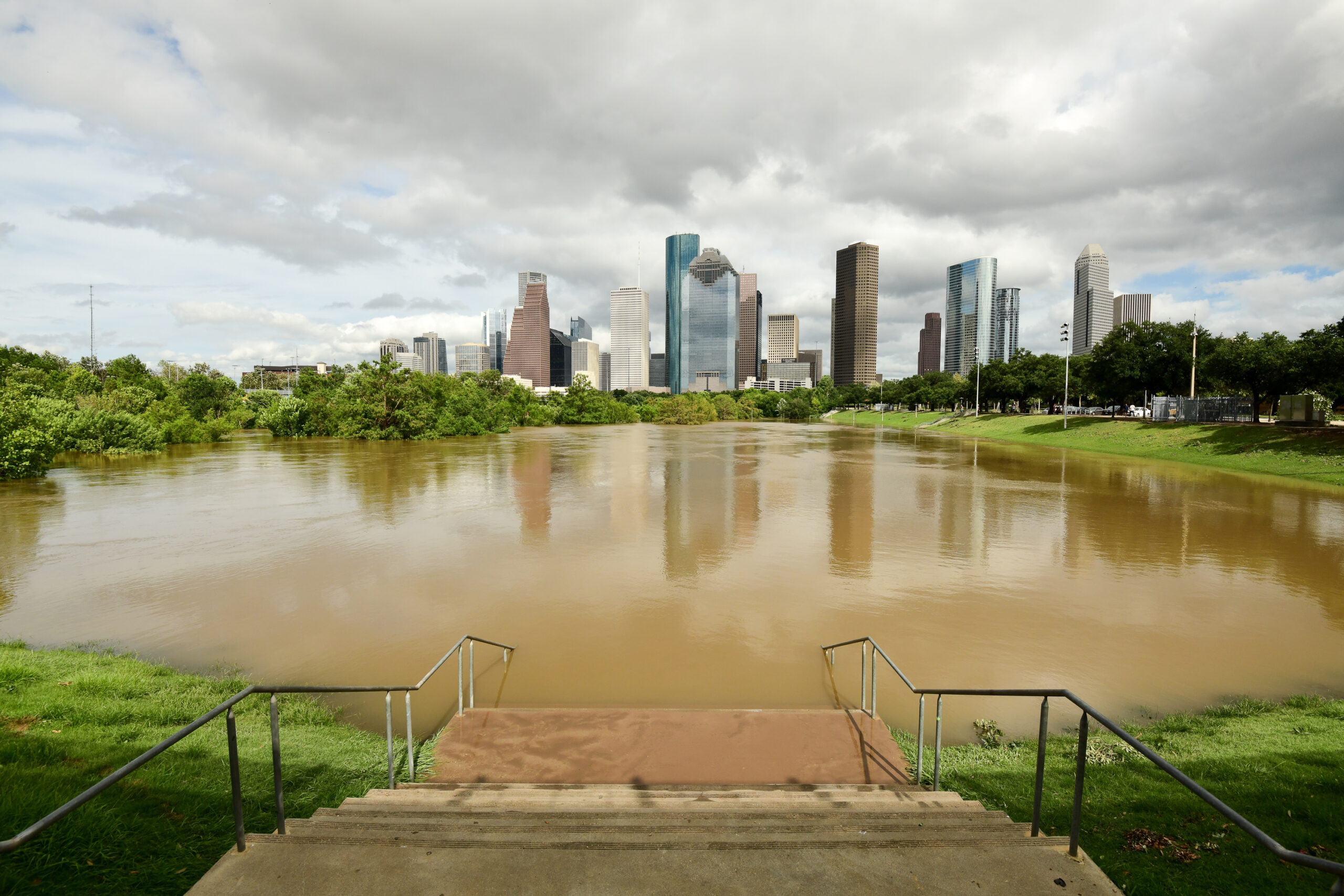When Hurricane Beryl entered the Gulf of Mexico, the city of Houston had little reason to believe it was about to take its first direct hit from a tropical cyclone in decades.
Initial forecasts predicted the storm would make landfall in northern Mexico, hundreds of miles away. Instead it veered sharply north and hit an unfortunate bullseye. Its center passed just west of Houston, dragging the hurricane’s violent eastern edge directly over the city’s core.
The category 1 storm flooded hundreds of homes and knocked out power for millions of people in the muggy former swamplands of the nation’s energy capital, throwing the city into days of chaos and highlighting the vulnerability of the fourth-largest U.S. city.
For Matt Lanza, a meteorologist and managing editor of Space City Weather, it raised a disturbing prospect: What if this mild hurricane had been stronger?
“It’s really uncomfortable to think about,” Lanza said. “That is a scenario that is extremely plausible; it’s not far-fetched.”
If a category 3 or 4 storm followed the same path as Beryl, Lanza said, it could drastically change the face of Houston. This week’s experience suggests the city is ill-prepared to handle such a disaster.
“It could be like New Orleans after [Hurricane] Katrina, where much of the city is uninhabitable for a period of weeks to months,” Lanza said. “So what is our plan for that? I don’t know that we necessarily have one.”
The last category 4 storm to hit Houston was Hurricane Carla in 1961, when less than a million people lived in the city and air conditioning was still novel. The last category 3 was Hurricane Alicia in 1983. Hurricane Ike, a category 2, landed east of Houston in 2008, striking the city with its weaker western flank.
Most damage in recent memory has come from tropical storms bringing much more rain than wind, like Tropical Storm Allison in 2001. Hurricane Harvey hit the middle Texas coast as a category 4 in August 2017 and reached Houston as a stagnant tropical storm with modest wind—but with the heaviest rainfall ever recorded in the United States, inundating the city with over 50 inches of precipitation.
When Beryl hit on Monday, it was wind, rather than rain, that wrecked the city’s electrical infrastructure, apparently catching the local power company, CenterPoint Energy, off guard. Four days later, CenterPoint was still working to restore power to hundreds of thousands of customers.
“A cat 1 hurricane shouldn’t knock out your power system,” said Kerry Emanuel, a veteran hurricane researcher and professor emeritus at the Massachusetts Institute for Technology. “I think you’ve got a problem with the power company, frankly.” Hurricanes are expected to intensify, he said, as greenhouse gas emissions warm the atmosphere and ocean, supercharging evaporation and heat transfer in a warmer atmosphere that already holds more moisture.
“A demonstrable greenhouse gas effect is the proportion of hurricanes that turn out cat 3 or 4,” Emanuel said.
When Hurricane Beryl formed in the Atlantic in early July, hundreds of miles from the Texas coast, it reached category 4 status–the earliest category 4 storm on record. Record warm temperatures in the Atlantic Ocean this year have led to predictions of a highly active hurricane season.
Beryl was the second time this summer that storms caused widespread, prolonged power outages in Houston, after a rare inland windstorm in May blasted through the city, blowing out skyscraper windows. The last decade also saw severe, widespread flooding in Houston in 2015, 2016, and 2017, plus a crippling ice storm in 2021 and severe drought in 2023 that ravaged underground plumbing.
This year’s hurricane season has only just begun. Atlantic storms typically grow more powerful through the summer, peaking in September.
“Houstonians are understandably exhausted from dealing with such events regularly, but it’s crucial that we remain prepared for more,” said state Senator Carol Alvarado, a Democrat who represents much of east Houston. “We must focus on increasing state aid for both preventative measures and reactive relief efforts.”
These storms harm economic prosperity and social mobility, said Robert Bullard, a professor of urban planning and environmental policy at Texas Southern University in Houston and a member of the White House Environmental Justice Advisory Council.
Less affluent communities typically bear the brunt of storm damage costs, Bullard said, because their infrastructure is lacking compared to wealthier neighborhoods. In the 20th century, he said, racial segregation forced Black families to live in low-lying areas that repeatedly flood.
In America, most middle-income family wealth is embedded in home ownership, Bullard said. When stormwaters swamp a house, the financial damage can last for generations. “This repeated disaster impacts on the communities over decades, it creates a theft of wealth accumulation,” said Bullard, who lost his car to Hurricane Alicia in Houston in 1983. “It’s stealing their inheritance, and it means that the amount of equity funding for the next generation is diminished.”
Houston is taking steps to harden its defenses.
Offshore, federal authorities are advancing plans to build an enormous, $57 billion system of barriers and gates, which has been called the largest civil engineering project in U.S. history and is expected to take 20 years to construct.
That project is designed to prevent a worst-case scenario—a major hurricane shooting straight into Galveston Bay, sending a storm surge up the Houston Ship Channel and into the massive waterside complexes of refineries and petrochemical plants that constitute the heart of the U.S. energy sector.
In the city, authorities have recently spent hundreds of millions of dollars widening bayous, the natural waterways that flow across Houston, which nonetheless overflowed during Beryl. Authorities also bought out thousands of homes in the flood plains. But many thousands more remain.
Jim Blackburn, co-director of Rice University’s Severe Storm Prediction, Education, & Evacuation from Disasters Center, said the city should fundamentally change its development pattern to mitigate recurring storm damage. “We ought to be very slow to rebuild in the same areas that flood over,” Blackburn said. “That’s not a popular position, but I think it’s a very important one.”
Blackburn, a veteran environmental lawyer, was surprised at the amount of damage done to Houston’s power system by Beryl’s 90 mile-per-hour winds and by the length of the ongoing effort to restore electricity. “I cannot imagine what 150 mile-per-hour winds might have done to this community; that’s what I’m horrified of. What’s a cat 4 or cat 5 going to do to us?” Blackburn said. “They will be coming.”
But fundamentally reformatting Houston is easier said than done. It means backtracking, to some extent, on decades of booming development driven by the hubris of the energy age.
Greater Houston started out as a smattering of settlements between swamps and bayous on the edge of a prairie. Until the mid-20th Century, there was “more appreciation for the vulnerability of the city” and “greater recognition of the city’s ecological and environmental infrastructure,” said Jonathan Levy, a professor of U.S. history at the University of Chicago who grew up in Houston’s flood-prone Meyerland neighborhood.
But that changed after World War II, when a period of rapid expansion brought an “an increasing ignorance of these realities,” said Levy, who has written about Houston’s environmental struggle. The oil and gas industry was revolutionizing the world, headquartered largely in Houston, where it powered the massive expansion of concrete freeways, whole landscapes of suburban sprawl, and an enormous, low-density city premised on private automobiles. At the same time, the growing global oil industry was increasing the greenhouse gas emissions that intensify tropical storms.
“When it comes to the politics of climate change, if you don’t have a plan for Houston, you don’t really have a plan,” Levy said. “It’s hard to imagine an energy transition occurring without the energy industry in Houston participating.”
As for the city, the transformation would entail making space for the water, pulling back from the edges of the bayous to create a giant network of wide greenways through the metro area.
“Limiting building, condemning property and compensating homeowners to bring the logic of that ecological infrastructure back to life,” Levy said. “If you can’t do that, I don’t really see there being any answer.”


